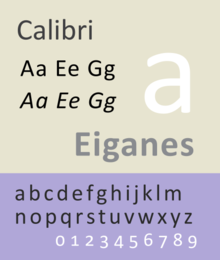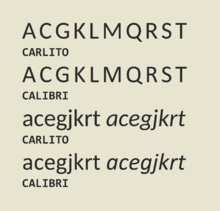Calibri
 | |
| Category | Sans-serif |
|---|---|
| Classification | Humanist[1] |
| Designer(s) | Luc(as) de Groot (Standard Latin, Cyrillic, Greek, and Hebrew); Mamoun Sakkal (Arabic); Ruben Tarumian (Armenian and Georgian)[2] |
| Foundry | Microsoft |
| Date created | 2002–2005 |
| Date released | 2007 |
| License | Proprietary |
| Metrically compatible with | Carlito |
Calibri (/kəˈliːbri/) is a digital sans-serif typeface family in the humanist or modern style. It was designed by Luc(as) de Groot in 2002–2004 and released to the general public in 2007, with Microsoft Office 2007 and Windows Vista.[3] In Office 2007, it replaced Times New Roman as the default typeface in Word[4] and replaced Arial as the default in PowerPoint, Excel, Outlook, and WordPad. De Groot described its subtly rounded design as having "a warm and soft character".[3] In January 2024, the font was replaced by Microsoft's new bespoke font, Aptos, as the new default Microsoft Office font, after 17 years.[5][6]
Calibri is part of the ClearType Font Collection, a suite of fonts from various designers released with Windows Vista.[7] All start with the letter C to reflect that they were designed to work well with Microsoft's ClearType text rendering system, a text rendering engine designed to make text clearer to read on liquid-crystal display monitors.[citation needed] The other fonts in the same group are Cambria, Candara, Consolas, Constantia and Corbel.[3][8]
Characteristics
[edit]Calibri features subtly rounded stems and corners that are visible at larger sizes.[8] Its sloped form is a "true italic" with handwriting influences,[9] which are seen in many modern sans-serif typefaces.
The typeface includes characters from Latin, Latin extended, Greek, Cyrillic and Hebrew scripts. Calibri makes extensive use of sophisticated OpenType formatting; it features a range of ligatures as well as lining and text figures, indices (numbers enclosed by circles) up to 20, and an alternate f and g (shown in sample) accessible by enabling the fourth and fifth stylistic sets.[10][11] Some features in Calibri remain unsupported by Office, including true small caps, all-caps spacing, superscript and subscript glyphs and the ability to create arbitrary fractions; these may be accessed using programs such as Adobe InDesign.
One potential source of confusion in Calibri is a visible homoglyph, a pair of easily confused characters: the lowercase letter L and the uppercase letter i (l and I) of the Latin script are effectively indistinguishable; this is true of many other common fonts, however.
The design has similarities to de Groot's much more extensive TheSans family (a humanist font) and shares similarities with humanist fonts, although this has straight ends rather than rounding.[12]
De Groot has also said in 2016 that he would like if possible to add Bulgarian alphabet variant letterforms at a later date.[13]
Availability
[edit]
Calibri was the default typeface of Microsoft Office and much other Microsoft software, replacing the previously used Times New Roman. Joe Friend, a program manager on Word for Office 2007's release, explained that the decision to switch to Calibri was caused by a desire to make the default font one optimised towards onscreen display: "We believed that more and more documents would never be printed but would solely be consumed on a digital device", and to achieve a "modern look".[14][non-primary source needed]
Because of the long development of Windows Vista, Calibri's development – from 2002 to 2005 – occurred several years before the release of that OS.[1][3] It was first presented in a 2005 beta of Windows Vista, then codenamed Longhorn,[citation needed] and first became available for use with the Beta 2 version of Office 2007, released on 23 May 2006.[15] Calibri and the rest of the ClearType Font Collection were finally released to the general public on 30 January 2007, since when it has been released with most Microsoft software environments.[citation needed]
Calibri is also distributed with Excel Viewer, PowerPoint Viewer,[citation needed] the Microsoft Office Compatibility Pack for Windows,[16][failed verification] and the Open XML File Format Converter for Mac.[17] For use in other operating systems and web apps, a license may be obtained from Ascender Corporation and its parent company Monotype Imaging.[18]
The Calibri Light font was introduced in Windows 8 and was retrospectively added to Windows 7 and Windows Server 2008 R2 as part of a software update.[19] Starting with Microsoft Office 2013, Calibri Light is the default font for PowerPoint presentations and Word headings.[19]
In 2013, Google released a freely-licensed font called Carlito, which is metric-compatible to Calibri, as part of ChromeOS.[20] Carlito's metric-compatibility ensures ChromeOS users can correctly display and print a document designed in Calibri without disrupting its layout. Carlito's glyph shapes are based on the prior open-source typeface Lato.[21]
On 13 July 2023, Microsoft announced that they would switch the default Microsoft 365 font from Calibri to their new font, Aptos.[22][23]
Awards
[edit]Calibri won the TDC2 2005 award from the Type Directors Club under the Type System category.[24] The Arabic typeface of Calibri won the 2nd Award of GRANSHAN 2016.[25]
In crime and politics
[edit]Because of Calibri's position as the default font in Office, several cases have been reported in which documents presented in Calibri were shown to be forged thanks to a purported creation date before 2007, when Calibri was made available to the general public:
- In 2017, the font came to public attention as evidence in the Pakistani government-related "Panama Papers" case (also known as Fontgate),[26] in which a document provided by Maryam Nawaz (daughter of ex-PM Nawaz Sharif) supposedly signed in February 2006 was found to be typed up in Calibri.[27][28][29][30] De Groot said that there was "really zero chance" that the document was genuine.[31]
- In 2009, a letter attributed to Bob Hayes, an American footballer and sprinter, which could not have been written after 2002, was found to be a forgery as it was typed out in Calibri.[32]
- In 2012, the Turkish government charged approximately 300 people with conspiracy to commit a coup. The incriminating evidence was a document alleged to have been written in 2003. The document, however, was written in Calibri, which was not available in 2003.[33]
- In 2017, a Canadian businessman named Gerald McGoey filed for personal bankruptcy. He produced documents showing he has transferred parts of his estate to be held in trust for his children. These documents, allegedly signed in 1995, were typed out in Calibri.[34][35]
- In 2023, Probate Judge Sandra A. Harrison of Macomb County dismissed a man’s claims against his parents for breach of contract and unjust enrichment after the defense counsel discovered that a business record, purported to have been signed on 13 December 2000, was typed out in Calibri.[36]
In January 2023, the United States Department of State retired Times New Roman in favor of Calibri for official communications and documents due to superior readability on a computer screen, and accessibility, since its sans-serif nature would cause fewer problems in the usage of text-to-speech and optical character recognition tools.[37][38]
References
[edit]- ^ a b Berry, John D. (2004). Now Read This: the Microsoft ClearType Collection. Redmond, Washington: Microsoft Corp.
- ^ "Calibri Font Family". Microsoft. Retrieved 8 October 2021.
- ^ a b c d Berry, John D.; De Groot, Lucas. "Case Study: Microsoft ClearType". Lucasfonts. Retrieved 11 July 2017.
- ^ "Microsoft typography: Calibri". Microsoft. Retrieved 10 December 2002.
- ^ Mather, Victor (28 February 2024). "Microsoft Word's Subtle Typeface Change Affected Millions. Did You Notice?". The New York Times. Archived from the original on 29 February 2024. Retrieved 11 March 2024.
- ^ "A change of typeface: Microsoft's new default font has arrived". Microsoft Design. Retrieved 11 March 2024.
- ^ "The Microsoft ClearType Font Collection". Microsoft Typography. Microsoft. Retrieved 31 August 2017.
- ^ a b Van Wagener, Anne. "The Next Big Thing in Online Type". Poynter Online. Archived from the original on 4 June 2006. Retrieved 31 August 2017.
- ^ Levien, Raph. "Microsoft's ClearType Font Collection: A Fair and Balanced Review". Typographica. Retrieved 24 November 2014.
- ^ Batchelor, Lee (23 October 2012). "Opentype Features in Microsoft Word". Leeviathan. Retrieved 7 July 2015.
- ^ "Package details: OpenType features". LucasFonts. Retrieved 2 October 2020.
- ^ Middendorp, Jan (2004). "The Two Sides of Luc(as) de Groot". Dutch Type. Rotterdam: 010. pp. 219–227.
- ^ Knecht, Sonja (9 October 2016). "European Cyrillics". TXET. Retrieved 31 August 2017.
- ^ Friend, Joe. "Why did Microsoft change the default font to Calibri?". Quora. Retrieved 25 April 2019.
- ^ Mondok, Matt (23 May 2006). "Office 2007 Beta 2 released for the masses". Ars Technica. Retrieved 18 July 2017.
- ^ "Download Microsoft Office Compatibility Pack for Word, Excel, and PowerPoint File Formats from Official Microsoft Download Center". Microsoft. Archived from the original on 29 April 2018. Retrieved 19 February 2013.
- ^ "Download Open XML File Format Converter for Mac 1.2.1 from Official Microsoft Download Center". Microsoft. Archived from the original on 5 May 2013. Retrieved 19 February 2013.
- ^ "Calibri". MyFonts. Monotype Imaging/Ascender Corporation. Retrieved 30 August 2017.
- ^ a b "An update is available to add the Calibri Light and Calibri Light Italic fonts to Windows 7 and Windows Server 2008 R2". Microsoft Support. Microsoft. Archived from the original on 12 June 2024. Retrieved 17 June 2024.
- ^ "A thank you to Google from Desktop Linux". GNOME blog. 10 October 2013.
- ^ "carlito – Support for Carlito sans-serif fonts". CTAN. Retrieved 22 October 2018.
- ^ Warren, Tom (13 July 2023). "Meet Microsoft Office's new default font: Aptos". The Verge. Retrieved 14 July 2023.
- ^ Microsoft Design (13 July 2023). "A change of typeface: Microsoft's new default font has arrived". Medium. Retrieved 14 July 2023.
- ^ "TDC2 2005: Winning Entries". Type Directors Club. Archived from the original on 18 February 2012.
- ^ "Competition 2016 – Winners". GRANSHAN. 13 June 2017. Archived from the original on 30 November 2023. Retrieved 12 January 2022.
- ^ Rasmussen, Sune Engel; Collins, Pádraig (13 July 2017). "'Fontgate': Microsoft, Wikipedia and the scandal threatening the Pakistani PM". The Guardian. Retrieved 31 May 2019.
- ^ McKurdy, Euan; Saifi, Sophia (13 July 2017). "At the center of a corruption case involving the Pakistani Prime Minister is a font". CNN. Retrieved 14 July 2017.
- ^ Clark, Bryan (11 July 2017). "Microsoft's default font is at the center of a government corruption case". The Next Web. Retrieved 11 July 2017.
- ^ Siddiqui, Zarin (12 July 2017). "We asked the creator of Calibri to weigh in on the JIT debate". Dawn. Retrieved 13 July 2017.
- ^ Jafar, Ovais (13 July 2017). "'Extremely unlikely' Calibri used in Feb 2006 to draft legal document, says font creator". geo.tv. Retrieved 4 August 2017.
- ^ van de Klundert, Mitchell (13 July 2017). "Het Nederlandse Calibri brengt mogelijk de Pakistaanse premier ten val" [The Dutch Calibri may cause the downfall of the Pakistani premier]. Nederlandse Omroep Stichting (in Dutch). Retrieved 14 July 2017.
- ^ Phinney, Thomas (6 February 2009). "Bob Hayes NFL Hall of Fame forgery". Thomas Phinney. Retrieved 29 January 2021.
- ^ Arbes, Ross (24 July 2017). "Calibri's Scandalous History". The New Yorker. Condé Nast. Archived from the original on 28 July 2017. Retrieved 1 August 2017.
- ^ Peters, Diane (15 May 2019). "The Font Detectives". JSTOR Daily. Retrieved 24 May 2019.
- ^ Bright, Peter (15 January 2019). "Microsoft's fonts catch out another fraudster—this time in Canada". Ars Technica. Condé Nast. Retrieved 21 January 2019.
- ^ Taylor, Michael (30 March 2023). "Font choice exposes fabricated document". Michigan Lawyers Weekly. Archived from the original on 30 March 2023. Retrieved 13 April 2023.
- ^ Gitlin, Jonathan M. (18 January 2023). "Time(s) for a change: State Department picks a new official typeface". Ars Technica. Retrieved 19 January 2023.
- ^ Coldewey, Devin (18 January 2023). "Font furore as State Department retires Times New Roman for retired Calibri". TechCrunch. Retrieved 19 January 2023.
External links
[edit] Media related to Calibri at Wikimedia Commons
Media related to Calibri at Wikimedia Commons
